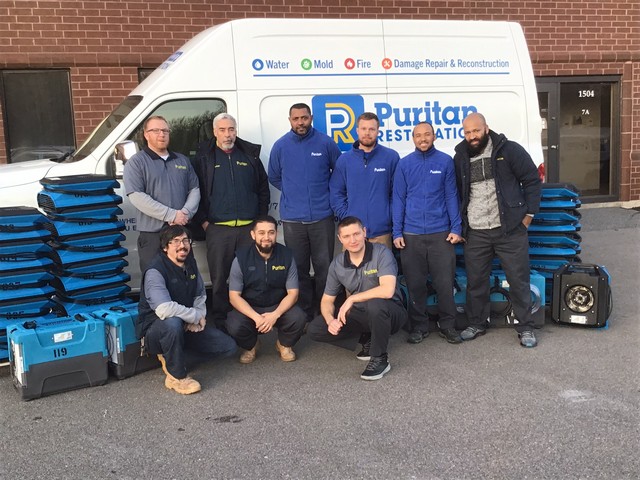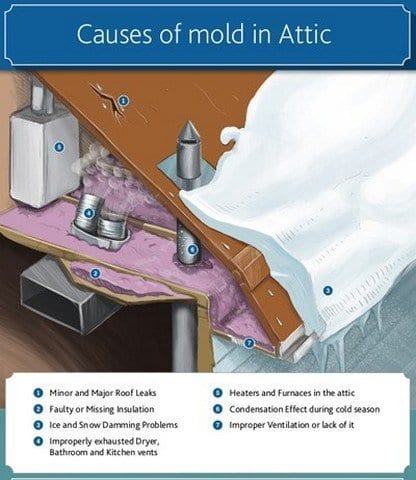Why Does Mold Grow In The Attic?

Top 4 Causes Of Attic Mold Growth!
Puritan Restoration is passionate about educating our readers in Norwood, Newton, Framingham, Cambridge, Needham, Brookline MA and surrounding areas about indoor air quality issues and mold.
This article provided you with detailed information on how to prevent mold after a flood.
Continuing on with our series of educational articles on mold, this article reveals the top 4 reasons why mold grows in attics.
Got Mold Concerns? Puritan Restoration specializes in mold removal. Our staff are highly educated and trained on all aspects of indoor air quality. We are experts at indoor air quality because your health and well being is our biggest concern. If you think you have mold, please give us a call, 617-527-2229 or send us an e-mail
#1 Fans Vented Into The Attic!
Mold will grow if there is moisture, food, and warmth.
Poor building practices occur when the dryer vents, plumbing vents, kitchen or bathroom fans are vented into the attic.
Dryer exhaust vents, kitchen exhaust fans and bathroom exhaust fans are designed to pump moisture out of your home. Make sure that they are vented to the outside of your home and not in the attic.
Plumbing stacks in the attic can also be a source of condensation, which can lead to attic mold growth. Plumbing stacks can also emit hazardous gases, so make sure that they too do not terminate inside the attic.
If any of your vents are routed into the attic, hire a reputable contractor to re-route the vents to the outside of your house.
#2 Leaking Roof!
If you have a roof leak, you may see water on your floors and water stains on the ceiling. The good news, you know that you have a problem.
However, if you have a roof leak and it goes unnoticed leading to moisture accumulation in your attic, this will eventually lead to mold growth that you may not even know exists.
This is the reason it is important to inspect your attic several times each year, just to make sure that there is no moisture buildup.
- Check for discoloration of insulation and wood (e.g. rafters, sheathing, joists, attic side of fascia boards, etc.).
- Check roof valleys (i.e. where two roofs join at an angle), which are highly susceptible to roof leaks.
- Observe skylights, chimneys, attic windows and any portion of the attic/roof where dissimilar materials join each other (including flashings). These places are hotbeds for potential moisture intrusion.
- If you have a vapor barrier installed, check for condensation. Although this is not really a roof leak, it is nevertheless a sign of a moisture problem. And moisture problems lead to attic mold problems!
- Make sure there are no leaks coming from and around attic plumbing stacks.
The first step to addressing the moisture cause is to get your roof repaired, then contact Puritan Restoration to remove the mold.
#3 Missing or Improperly Installed Insulation!
The quest to save money on heating and cooling bills motivates many Do-It-Yourselfer’s to install more insulation in their attics.
Unfortunately, if the wrong kind of insulation is chosen or if it is installed improperly, this can cause moisture from the lower levels of your home to rise and get trapped in the attic.
The primary cause of mold growth is moisture. Your attic is made of the food mold loves to feed on.
With respect to the type of insulation, if you are layering insulation on top of other insulation, make sure you do not use the kind that has paper or foil backing because it acts as a vapor barrier and can trap moisture in the insulation.
Before you decide to add more insulation to your attic, determine if you need more first. If you are unsure, contact a professional.
#4 Inadequate Attic Ventilation!
One of the problems we have encountered in our projects is the fact that insulation is blocking the ventilation ducts that distribute air in the attic.
The lack of ventilation is another major cause of mold growth in your attic.
Air travels up to the attic meaning activities such as cooking, bathing, showering, etc will produce moisture that will makes it way up to the attic. If there is poor ventilation, the moisture gets trapped in the attic and can lead to mold problems.
Check your soffit vents and make sure they are free of insulation, bird nests, and other debris that could be blocking them and preventing proper air flow.
If you are unsure if the ventilation is ideal in your attic, give us a call so that we can take a look.
If You Think You Have Mold In Your Attic, Call Puritan Restoration, 617-527-2229!

If You Think You Have Mold In Your Attic, Call Puritan Restoration, 617-527-2229!
Once the cause of your attic moisture issues are identified, then the next step is to determine if you have a mold problem.
Mold is nature’s recycler and will grow and proliferate when moisture is present.
Condensation in an attic, heat and humidity from household activities (cooking, showering, etc.), and the fact that the attic provides an excellent food source for mold, provides the ideal conditions.
All mold needs to grow is 24 to 48 hours and as long as the proper conditions exist, it will continue to proliferate.
If you do find mold in your attic, DO NOT use bleach or try to kill the mold!
The first step is to contact Puritan Restoration for a mold inspection and air quality test. During the inspection, tape or swab samples of suspected mold may also be taken and sent to a micro-biology lab. Once the type of mold and spore count is determined, we will provide you with a scope of work on the best way to remediate the mold in your attic.
Got Attic Mold Questions?

Got Attic Mold Questions?


Recent Comments